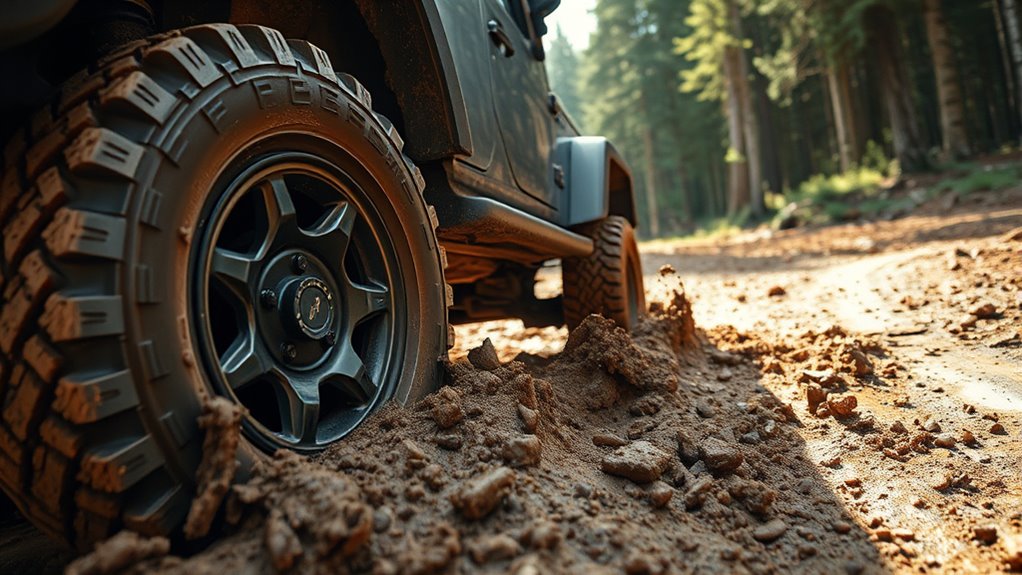All-wheel drive (AWD) distributes power to all four wheels automatically, enhancing control on paved roads. It adjusts to conditions without your input, making it user-friendly. On the other hand, four-wheel drive (4WD) requires you to manually engage it, delivering maximum traction in rough terrain. It’s ideal for off-road driving and features low-range settings for tackling obstacles. Understanding these systems helps you choose the right vehicle for your needs, and there’s more to explore about their differences.
Key Takeaways
- AWD automatically distributes power to all four wheels based on road conditions for enhanced stability and control.
- 4WD requires manual activation, sending power to all wheels for maximum traction in off-road scenarios.
- AWD systems continuously monitor and adjust power distribution without driver intervention, making them user-friendly.
- 4WD often includes low-range gearing to help vehicles navigate over obstacles in rugged terrain.
- Regular maintenance is crucial for both AWD and 4WD systems to ensure optimal performance and longevity.

Whether you’re steering through slick roads in winter or tackling rugged terrain, understanding the difference between all-wheel drive (AWD) and four-wheel drive (4WD) can profoundly impact your driving experience. Both systems enhance traction, but they do so in distinct ways. Recognizing how they work helps you choose the right vehicle for your lifestyle and guarantees proper vehicle maintenance.
All-wheel drive (AWD) is designed for on-road use and is usually found in cars and crossovers. It automatically distributes power to all four wheels as needed, which means you don’t have to think about changing settings while driving. This intelligent system continuously monitors the road conditions and adjusts the power between the front and rear wheels accordingly. That way, if you hit a patch of ice or mud, the vehicle’s computer senses the loss of traction and sends power to the wheels that need it most, improving control and stability. Since AWD systems are generally always engaged, you won’t have to worry about switching it on or off, making it incredibly user-friendly.
All-wheel drive (AWD) offers seamless power distribution for enhanced control and stability on paved roads, making it user-friendly for everyday driving.
On the other hand, four-wheel drive (4WD) is typically found in trucks and SUVs, designed for off-road capability. It often requires you to manually engage the system, usually through a lever or switch. Once activated, 4WD sends power to all four wheels, providing maximum traction in rough conditions like rocks, sand, or deep snow. Many 4WD systems also offer different driving modes, such as low-range gearing, which is ideal for crawling over obstacles. However, the added complexity means that proper vehicle maintenance is essential. You’ll need to keep an eye on the drivetrain components, as they can wear out faster with the demands of off-road driving.
Ultimately, your choice between AWD and 4WD boils down to how you plan to use your vehicle. If you mostly drive on paved roads but occasionally face challenging weather, AWD may be the better option. However, if you love off-roading or need to navigate tough terrain regularly, 4WD is likely more suitable. Both systems can enhance your driving experience, but understanding their differences will help you make an informed decision. Knowing how to maintain your vehicle, especially the drivetrain components, will guarantee that you get the most out of whichever system you choose, keeping you safe and confident on the road or trail. Additionally, recognizing the importance of proper vehicle maintenance can significantly improve the longevity and performance of your AWD or 4WD system.
Frequently Asked Questions
How Do All-Wheel Drive and 4WD Systems Differ in Performance?
All-wheel drive (AWD) systems offer better traction control in various conditions, automatically distributing power to wheels needing it most. This provides a smoother ride on wet or slippery surfaces. In contrast, four-wheel drive (4WD) is designed for tougher terrains, allowing you to manually engage power to all wheels when needed. However, 4WD usually has more drivetrain complexity, making it less suited for everyday driving compared to the more versatile AWD systems.
Can I Switch Between All-Wheel Drive and 4WD While Driving?
You can’t just flip a switch while cruising down the road! Switching between all-wheel drive and 4WD depends on your vehicle’s design. Some allow you to change modes on the fly, while others require you to stop. It’s all about driver preference and your specific needs. Always check your owner’s manual to see what’s safe and recommended for your vehicle. Remember, “better safe than sorry” when it comes to your ride!
Which System Is Better for Off-Road Driving: All-Wheel Drive or 4WD?
For off-road driving, 4WD is generally better than all-wheel drive. With its rugged drivetrain design, 4WD offers enhanced traction control on challenging terrains like mud, rocks, and steep inclines. You’ll find that it allows you to switch to low-range gearing, providing more torque when you need it most. While all-wheel drive excels in slippery conditions, 4WD gives you the confidence and capability to tackle more demanding off-road adventures.
Do All-Wheel Drive and 4WD Affect Fuel Efficiency?
Yes, both all-wheel drive (AWD) and four-wheel drive (4WD) can affect fuel consumption. Typically, these systems add weight and resistance, leading to decreased fuel efficiency compared to two-wheel drive vehicles. If you’re concerned about environmental impact, opting for a vehicle with AWD or 4WD might not be the most fuel-efficient choice. However, if you need the extra traction for off-road driving or adverse conditions, the trade-off might be worth it for you.
How Do I Know if My Vehicle Has All-Wheel Drive or 4WD?
To know if your vehicle has all-wheel drive or 4WD, check the owner’s manual or look for a switch or button labeled “AWD” or “4WD.” You can also inspect the drivetrain under your vehicle; if it has a transfer case, it likely has 4WD. For proper vehicle maintenance, verify your tires have good traction, as this can affect performance in various conditions. Don’t forget to ask your mechanic if you’re unsure!
Conclusion
In the end, whether you choose all-wheel drive or 4WD, it’s about matching your vehicle to your needs. Both systems offer unique advantages, but knowing when and how to use them can make all the difference. Think of your vehicle as a trusty companion on the road; with the right drive system, you’ll tackle any terrain with confidence. So, what adventure will you set out on next, knowing you’ve got the right support beneath you?










